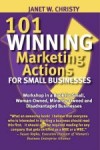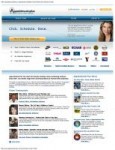We’ve all seen them- business websites with a 5 minute flash intro that you can’t bypass, product purchase links that lead to nowhere, or the dreaded contact page with no contact information anywhere to be found. So, to help avoid common business website pitfalls, the CarolRoth.com contributor network of entrepreneurs and experts have provided their best tips for improving business websites. Their answers are presented below in no particular order.
You may notice some similar insights, but I kept the concepts separate, as something in the way one is framed may resonate differently with you.

1. Don't Automate, Personalize!
When tracking your metrics, don't be afraid to reach out to your customers in a cost effective manner, such as a "survey monkey" to see if they have any suggestions. A survey monkey doesn't cost anything and what you learn from these surveys may surprise you!
We can learn from our customers.

2. Markets not Marketers
Long before you ever start developing information architecture or visual design is the strategy stage. Those very important concepts come from the market, not your marketers. Understanding both the expressed and unexpressed needs of your market will make for a better site. If you have an existing site, your analytics and metrics can give you a clue: look at the engagement metrics on your content. It's a great place to start.
Thanks to: Robert Rippee of
FORMO.

3. Option Overload = Lost Sales
As entrepreneurs, we want to make the client happy. We want to be their everything. Being an avid number cruncher, I love variations. 15 different options? Piece of cake. Unfortunately, studies show that the more options you give someone, the less likely they are to buy. Yes, I sweat bullets to limit myself to 2 or 3 product options, but I make more sales!
Remember when selling, less IS more.

4. Inform, Entertain or Incite
A website should serve its master - the business it represents. The intent of the website should drive its appearance and content. What the business wants from the website determines the intent. So the question is: do I need for my website to inform, entertain, incite or a combination? A word of caution, if a business website does not incite the visitor to take action, it may be wasting the business's money and time.

5. Anybody Out There?
Make it easy for your prospects & clients to contact you. Make it very visible. Make sure that the links in your contact form are working. It's also a big turnoff when contact phone numbers are not listed. It makes the website visitor wonder what kind of operation you are running. Are you a real company? Do you have so much business that you can't be bothered with a phone call? If you are not accessible prior to doing business, there is not much confidence in that area going forward.

6. Change it Up!
Websites, even business websites, should have some information that changes on a regular basis. Blogs are good, "Tip of the day" is good, but something to keep people - and search engine spiders - interested. If your website looks like it did a year ago, you've got a problem.

7. Optimize 4 Local Search Terms
Local search is one of the quickest ways to rank quickly and people are getting more intelligent with their search terms.
Business owners should pay particular attention to the on-page content of their website(s) including having sitemap.xml and robots.txt files installed on your root directory, as well as Google webmaster tools verified and setup.
Name your images and remove those old-fashioned flash files!
Make it easy for Google and Google will make it easy for you...

8. "Tag" Your Success!
My one best tip for improving the efficacy of your business website is keep in mind that it is a given that your website must be professional, organized, easy to read and easy to navigate through. In addition, as the stature of your brand and your business grows, "TAG IT" to your website. This not only builds your credible resume, but captures people's attention because of the significant things that you and your business have accomplished. Significant and credible social proof is important.

9. How Can I Reach You?
If there is no phone number, text or web chat available, I am a click away from your competition. I especially like to see a phone number so that I can call if I have any questions. Without one, I'm gone! It's like the zero out option on the telephone. There are times that speaking to a human is a necessity, not a luxury.

10. Share This
Ensure that on each page, there is a widget so that the reader can share the page through social media or email!

11. Blog Blog Blog!
Every business person knows that they need to have a blog. A blog allows people - potential and current customers - to see you as an expert in your field. Being a thought-leader is important in every industry. People like to do business with people who know what they are doing and can communicate that fact. But, once you start a blog - YOU HAVE TO BLOG regularly. It doesn't work if you set up a blog on your site, blog once and never blog again. So get blogging - short and sweet is all you need!

12. Let Us Speed Read!
The number one improvement you can make to your website is to ENLARGE THE FONT SIZE! I know a lot about the psychology of how/why Americans read, and I know they are tired of SQUINTING at tiny, gray print. Rather than "go to the trouble" to enlarge the screen, they will tend to click away to something else.
Believe it! Go to 16 or 18 pt black or blue and see the difference. Get rid of ANYTHING gray on your site while you are at it. USE COLOR! This is still the land of the living!

13. Most Important "Get Found" Tip
The single most important thing you can do to dramatically move up in search engine rankings is to put the keyword in the URL name of your site. HearingAids.com is better than BobsHouseOfHearing.com. When I changed from JimAckermanSpeaks.com to MarketingSpeakerJimAckerman.com, I shot from "nowhere to be found" to the top of page 2 in a couple of months. (I also got the keyword onto every site page.) Create a separate landing page for each keyword and get that keyword in the URL for that page.

14. Tell Them What You Want
Just like in the business world, selling what you have to offer as a product or service requires you to ask for the sale. On your website, the same is true as well. Make sure on your website there is a way to provide information to generate a sale or at the very least, a way to capture contact information, so that you can follow-up and get a sale in the near future. If you don't ask, you won't sell, so make sure to convey a strong position and tell your prospective clients what you want from them.
Thanks to: Myles Miller of
LeadUP.

15. Content is King
Websites rule where content is the focus. Elegant, sophisticated designs are important to establish your image and reinforce your brand, but if you don't include interesting articles about your business by the experts on your team, you are missing out. Content-rich sites are also attractive to search engines. There's no trick to it. Write well about what you know and you will reign when it comes to impressing current and future customers — and reporters, too.

16. Reel Them in With Video
We used to have 7 seconds to engage someone with content. In this world of immediate satisfaction, you now only have 3. Studies show that held up side to side, someone is more likely to click play on a video than sit and read a page of copy. Video is a great way to showcase your personality, products and services on your website, be an expert, and boost your SEO rankings by hosting them on a YouTube account. Video can be used in any business, so get creative! Find a way or quickly fall behind.

17. Get Real
Websites that use corporate-speak and stock photos are boring and ineffective. They fail to establish a connection with the visitor. A good website uses conversational copy along with real photos. It reflects the personality of the company.
Visitors to your website will sense if you're genuine. If they believe you're sincere, they're more likely to trust you and buy from you.

18. You Have a Website. So What?
You should be designing your website, first, around its purpose. Why do you have one? What do you want it to achieve? Second, consider your target audience. Who is viewing your website? Why? Once they see it, what should they be thinking? Doing? Third, how and when are people viewing your website? Is it designed to optimize their experiences on handhelds versus desktops? Does the design and content of your site support your answers to these questions?

19. Make it Easy to DONATE!
Online donation is increasing because it is quick, convenient, saves the cost of a stamp and it's green!
Much to my surprise, in my work with Synagogues and Jewish Charities, I have found that many do not have a simple online donation system and some do not even have a donation portal on their website!
This is a missed opportunity for support that is sorely needed.
All charities should have a clearly marked "DONATE" button on their home page and every page throughout their site.

20. ME, ME, ME... I, I, I...
Is your whole website comprised of you talking about how great your company is? If you want to intrigue your target audience and stimulate page-turning traffic, give them solutions to their problems. By identifying buyer personas and anticipating what your demographic wants, you can shape your website's content to provide useful knowledge and practical solutions, instead of being that guy at the party that only talks about himself. Think like a consumer and start converting visitors to leads!

21. No More Stale Content
Search engines tend to come to websites on a more frequent basis when the content is updated consistently. Make your website enticing by adding relevant articles or podcasts that offer tips to your target customers. Keep offering special deals at least on a monthly or quarterly basis.

22. Marketing is Entertainment
McLuhan predicted what is happening in today’s digital economy, yet the average sales strategy relies on increasing options, piling on statistics, and following fads, and they just don’t work. Remember, marketing is psychological persuasion and the best tool you have to accomplish it, is education, and education is all about how you deliver the message. McLuhan: “Anyone who tries to make a distinction between education and entertainment doesn’t know the first thing about either.”

23. Leave Them Wanting More...
Keeping your website up-to-date with compelling information is key to to having a website that works. Businesses often create a website and stop. Websites are living things: Blogs, articles, videos - stories about the industry and business make a website a valuable resource for your potential clients (and current clients as well). Make it fun, funny and compelling! Bribe visitors to call you with special offers. Leave site visitors wanting more of you and you'll convert them into clients.

24. Keep Adding New Content
For example, my website is a WordPress blog that I update at least five days a week. The top of the home page has a welcome video and few buttons that tell people more about me.
The rest of the home page shows the introductions to the most recent blog posts with a link to the entire post. People return to my website frequently because they know that everyday, they'll find new content that will help them on their career success journey.

25. Become the Customer You Seek
It is entirely too easy to presume what your customer seeks when designing a web site. Ask yourself these simple questions before starting work. (1) What does the customer seek? (2) What are they willing to pay for it? (3) How can I help them find it quickly and efficiently? (4) Why should they order from me and not my competitors?
Any entrepreneur is overcome by the euphoria of what they have to offer. Each of us is convinced that we will capture the magic. Do your homework first!

26. The Missing BIG 3
Business websites require 3 basic elements to make them effective. When it comes to Web marketing, small business owners need to: 1) Go out and get found, 2) Engage and 3) Follow up.
Most business owners focus all of their time and attention on getting found and completely miss keys # 2 and 3. This makes their website another "brochure" in the marketplace, generating little to no revenue for their business.

27. #1 Business Website Mistake
As a marketing consultant and copy writer, the #1 mistake I see being made on business websites over and over is a lack of calls to action. Calls to action are asking your website visitors to take action, such as to call now for a free consultation or buy now to get free shipping. A business website is a sales tool and you need to lead website visitors to do what you want them to do to move the sales process forward. Include calls to action and you will see your leads and sales increase.

28. Get Interactive!
Websites these days need to be interactive and not just a static online brochure with basic information, especially those of service-based businesses. Customers expect their service providers to offer online benefits, such as self-scheduling and the ability to pay for services without having to pick up the phone or send an e-mail. Features such as these not only are appreciated by customers, they also keep a business open 24 hours a day.

29. Is "Pretty" the Main Goal?
Think through what you want your site to convey. If you're a business site, it's probably best to leave behind the idea that "pretty" is a top priority. Boutique sites can be pretty, yes, but you won't see a news-site or professional business site centering all of their text, tossing flowers everywhere, adding polka-dots to the background or using rainbow colored text on their pages. This screams "Amateur." Study other business sites - don't copy - but do respect their wisdom of simplicity.

30. Make it Beautiful
Make sure your website has a clear, intuitive layout and lots of eye-grabbing, gorgeous photos. Think of it as a magazine: it ought to be beautiful.

31. Simple Equals No Confusion
This is a challenge for me and many others. You have so many things you can provide your customers and want to make sure they know about all of it!
DO NOT DO THIS! Keep your site narrowed down to one or two key areas/ideas/solutions/products and focus clearly and heavily on just these.
If a visitor cannot find what they want almost immediately, they will leave! Give them a clear path that this is what they want and how they can get it; they will stay and buy.

32. Make it Easy!
Find out what most people accessing your site are coming there for and make that the easiest thing to do. Alternately, think about what YOU want them to do, and make THAT the easiest thing to do. Use a big, bright button to get them to work toward your goal (buttons should do the same thing on every page of your site. So should tabs, links, etc.).

33. Check, Re-Check, Check Again
Make sure all of your links, buttons and images are working. Little computer gremlins, I think, come into web sites and suddenly, your buttons or links are going nowhere or going to your error page.

34. Why aren't You MOBILE?
I don't know about the rest of you, but I am never in the office. I live on the road and my blackberry is my phone, email device and my web browser. However, it still amazes me that 95% of the emails I get with links to the web have not created mobile friendly content. When on the road, I want to be able to access who you are, what you do, understand your call to action and be able to contact you. Frustrating to do from a non-mobile website. For an example, type my URL into both and see.

35. Quiet, Please!
It's wonderful to see business owners using audio and video on their websites, as well as in their social media arenas, but there's one mistake that can cost you business: having the audio start on its own. Research studies show that most people scramble to either mute the audio or get off of the web page that unexpectedly started making noise. Don't surprise your visitors in a bad way - let them opt to listen to or view your multimedia messages. You'll have their buy-in and that's a win-win!

36. Does it Make Sense to Newbies?
The biggest mistake I see that people make in websites is that they assume the person coming to the site knows as much about their product/service/industry as they do. Detailed information for the educated seeker is a must. But remember, some people are there for the first time and haven't a clue what your acronyms stand for, what industry terminology actually means or other things we 'in the know' take for granted. Be sure to define terms and acronyms when used for the first time on a page.

37. Let Your Website be Seen!
It's important to make sure that your website is visible to and readable by all kinds of devices - computers, phones and tablets - as well as search engines. Make sure to check out your site on all kinds of devices; if you have Flash elements, they may not run. If you have graphics rather than text on your homepage, you won't be as searchable; if you have too much going on on your homepage, everything will be tiny and unreadable on a phone. Keep it simple, readable and use good keywords!

38. Are Websites Doing Their Job?
The most common mistake that most websites make is that they are a glorified brochure, as opposed to a marketing and sales machine. A website should make the visitor want to take an action of some sort. There should be excellent content and all bases need to be covered, but if you want the visitor to buy, want to know more, or even get them to pick up the phone and call, then your website must be set up to do that. Better yet, ask your customer what they want to see.

39. Small Change, Big Results
I have significantly increased my client's revenues with small changes to their websites. My favorite is putting an 800 number at the top of every single page on the site. This does two things- 1. Many customers fear using their credit card online and prefer to order over the phone. For one major retailer that I worked with, phone orders accounted for 25% of sales on $130 million in revenue. 2. An 800 number adds credibility. Make it easy for customers to order from your site!

40. "F-word" Doubles Website Sales
Many successful and respected companies use the "F-Word" (i.e. frequency) in their email marketing to increase website sales. Mailing your list daily (at least 5 days per week) with fun and useful information (that also plugs your website each time, with a clear call to action) makes both reading and buying from your emails fun. Customers love getting emails like this. And in some cases, doing this can as much as double website sales in 30 days or less.

41. Find Your Leaks and Fix Them!
95% of websites leave money on the table - and their owners usually have no idea!
Find out where your site is "leaking" resources - whether in missed opportunities for revenue or lead generation (e.g. high exit rates because of poor calls to action), or in spending money to little or no effect (e.g. pouring dollars into non-performing adwords).
Find out what's really going on by drilling down in your analytics - a small tweak to your site or your marketing strategy can make a huge difference.

42. Be Crystal Clear
One of the biggest internet mistakes business owners and professionals make is not being crystal clear about what they have for me, why I should buy it, and what they want me to do now that I've found them.
This means being crystal clear about: (1) What you are selling, (2) To whom are you selling it, and (3) Why they will buy it from you. Is your site a brochure site or an internet sales site? Be clear about that, too.
If you're not "crystal clear," your site won't be effective.

43. Teach Your Website to Talk!
A Harvard study concluded that the brain is like a sieve! Within 1 hour, your prospect will forget 55% of the information read on your site. I use a technology called AudioGenerator. It allows me to easily post audio greetings, promotions or special messages on any webpage. More importantly, by adding a short audio message, you can increase your client's information retention by 50%. Click on the link below to try it for free. http://members.audiogenerator.com/specialinfo.asp?x=786599

44. Verry Impotent Two Spell Wel!
One of the most important things businesses can do to improve the efficacy of their websites is to make sure everything on the site is spelled correctly. One small error can change the meaning, offer something unintended, or offend people. If you don't take the time to make sure it's written properly, your customers may think you won't take the time to treat them right either.

45. We Can't See You!
One of the biggest mistakes people make is to not have a picture of themselves (or their team) on their site.
It's been proven that sites with photos have a higher conversion rate for products and services than those without.
Put a photo of you on your site as soon as you can if you have not yet - it enormously magnifies the trust factor.

46. Quick, Creative SEO
With all the noise out there, we are coming up against the age old question: "How do I make my voice heard?" Here is our solution: First, hire us to do your SEO. Second, focus on your links! Use the tools out there- the best one we recommend is Wikipedia. Put your business on there properly, comment on relevant stuff, read and follow their rules. If you do it right, you have an easily searchable, credible link to your site.

47. Combine SEO, PPC, CRA
A combination of Search Engine Optimization (SEO), Pay Per Click (PPC) advertising, and Conversion Rate Analysis (CRA) will raise your website's visibility to the top of the search engines. Make sure you select relevant, effective keywords that are highly utilized by your target audience, but not overly saturated by your competition. Also, be sure your PPC ads are persuasive enough to get your audience to click through.

48. Enable Social Sharing
You already spend a lot of time, money, and effort getting people to your site. Give them a way to pay it forward. After they are wowed with your site's content, get them to share it with their network. It could be as simple as making the request (e.g. "Like this post? Click here to share it on LinkedIn!") or use the motivating power of giveaways to have them spread the word. When they share your site with friends, you earn increased awareness & targeted clicks back to your site.

49. Just Press Here
Your business website is a marketing tool; it needs to have a call to action. Your website should contain a clear call to action on every page. Let your customers know where to click and what to do next.
So many websites are just online brochures with little thought behind what the company or business wants the customer to do when they get to the site. Make it easy on them with a clear call to action or buy here button.
Even better, is a website that converts to sales.

50. Get Your Site Up Quickly!
Many small businesses wait to get the perfect site and wind up delaying their launch by 1-2 months. Simple, expandable sites can be created using WordPress and Joomla to get your site up and running in one day, which then gives you time to hone your message and find initial customers to fund the next phase of development. These are sample sites that I put together in less than 4 hours: http://blog.GermanParade.org and http://blog.GermanParade.com

51. Be Found at the Right Time
The best tip I can give entrepreneurs is to find out what keywords their prospects are searching online to find their products/services and optimize their site for the search engines, so when that term is typed, their site shows up first. This brings traffic to their site from prospects who want what they sell. The biggest mistake I see people making is not filling out the title, description and keyword tags. How is a search engine going to rank your site if you don't tell it what the site is about?

52. Keep it Simple!
I come across a number of websites that have so much content on the homepage. Sometimes online, less is more. And don't forget ASK FOR THE SALE! As a visitor, I am there because you have something I need or want; make it an easy process for me to spend money on your site.

53. Outside in
Make sure you see your website from outside of your organization (and not on your designer's system either!). See it how it would look on a customer's computer and bandwidth... Not everyone has 4g of RAM and a T1. Make sure it looks how you want and loads 'fast' for the person who is going to use it.

54. Build Your List
Regardless of what your website sells, physical goods or information, have an opt-in sign-up form to capture email addresses of folks who raise their hands to say they want to hear from you again.

55. Add Your Opt-In on Every Page
One of the biggest mistakes most people make on their websites is they either don't have an opt-in, or if they do, the opt-in offer isn't compelling. It's not enough to offer your prospects a subscription to your ezine anymore. Think of your opt-in offer as your secret sauce. Answer this...what is something that people want the answer to (that you can provide) so badly, they're willing to give you their name/email address to get? Make it compelling and they will want it. That's a win-win!

56. Some People Hate Phones
Part of the power of the web is its ability to be interactive and engaging. For many people, one of the most frustrating types of business websites are those that force users to call in, instead of offering robust online features, whether it be live chat, real-time scheduling, or online shopping carts.
Indeed, take advantage of cheap and free online tools to augment your site and offer your clients a more fulfilling user experience in real-time, 24/7.

57. Make it Minimal
When it comes to making effective websites, live by the motto: "When it doubt, leave it out". Most website owners don't grasp the necessity of streamlining their sites to remove all unnecessary distractions.

58. Tell Me Please!
Did I come to the right website? Is the website for me? Why should I spend my precious time continuing to read this site? Where can I get other information? How do I easily contact you? Those are the questions websites need to answer, and answer very quickly. Not only that, they need to answer all of those questions without me scrolling down the page! Now that's efficient website marketing.

59. Video Testimonials
Ever see those anonymous testimonials where "Fred from Buffalo" just loves your product? Ever wonder if there really is a Fred from Buffalo? Ever buy the product? How about real people, with real first AND last names, looking straight into a camera and honestly testifying on your product's behalf? A simple flip camera, basic video editing software and a web designer who won't nickel and dime you for every new post is all you need. The year we added VT's was the beginning of our break through.

60. Give Me a Really Good Reason
Give me a really good reason to do business with you. On your website, offer me a free consultation, give me a free report or newsletter, post some before and after photos or stories from happy customers. I found your site, so that means I'm looking for someone who does what you do, but I need some "good" reason to choose you over the rest.

61. Stop Being Too Fancy!
My tip for improving your website is actually one of my peeves: don't use flash! When potential customers are looking for you, they don't want to spend too much time swimming through a website full of flash and clutter. Have a website that is beautiful, clean, navigable and full of value. Have a head-turning headline. Less is more and value is priceless!

62. Be Seen as a Solution Provider
Too many websites focus on product or service features, instead of benefits. The site visitor should be exposed right on the home page to the solutions they seek. They should feel that they have arrived on a site that understands them.
e.g. "Are you overwhelmed with all of the marketing information out there? Are you confused and frustrated, not knowing how to promote your business? Watch the video below for 7 Powerful Tips that WILL help you generate more leads and attract more customers."

63. Simple Idea Hard to Remember
Your contact info should not be something people have to dig for. The "about" section is the only navigation point it should be hidden in and it really shouldn't be there either. If you are using wordpress, make sure the contact info is in your profile. It's a simple thing to forget and a lot of people do.

64. Website Ready for Business
The action you want the visitor to take must be front and center. As a web designer, I am appalled at sites that feature a lot of text, where you have to hunt to even find the product you're looking for, and then, you can't find the "add to cart" button.
Visitors spend 30 seconds or less on a site before deciding if they want to purchase. The first page must clearly show them what they want and how to get it. If the site sells a
lot of products, there must be an easy way to find one and buy it.

65. Business Website Mistakes
Always keep in mind that people search the web for information and/or to solve a problem. They do not care about your great customer service. Have a specific goal in mind before you build your site. For example, do you want to generate leads? Focus your copy on your customer & identifying & solving their problem. Talk about them, not yourself.
Count how often you use words like "I, us, me" vs. "you, your". You want to be sure you are using words in the second group much more than the first.

66. Press Friendly Web Site
Is your business web site press friendly? Many times a reporter or writer will visit your site doing research on an article about your company, industry space, etc.
1. Make sure that your press page is easy to find
2. Make sure that you have a clear and concise description of what your company does, as well as a history
3. Include all recent press releases, product photos and data sheets, as well as a listing of positive press coverage that your company has recently received
4. Have a PR contact

67. You Need to Be Accessible
It drives me nuts when websites don't have a clear and easy way to contact them. And in particular, when they don't list a phone number and/or address. You never know how your visitors might prefer to contact you. After an event, I was sending out Thank You cards. At least half of the cards couldn't be sent because there was no address to be found on their site, on their web registration or in Google. Always list multiple ways to be contacted - email, phone and address.

68. Don't Lose That Visitor!
Offer a free informational report or coupon in exchange for your visitor's email address. People love free. Visitors come and go so fast on the internet while shopping for services that they very rarely stay at one site long. When that visitor leaves, you will probably never see them again. The free report is a way to show your expertise and allows you to stay in touch with that person shopping, so you can learn more about their needs. This might eventually turn them into a customer.

69. Make it Easy!
Make it easy for your customers to buy from you. I come across many sites that are so hard to navigate and find pricing & buying information. I absolutely hate the ones that ask me to phone to purchase or even worse, to find out the pricing. Many website owners fall so much in love with design, technology, and all other wonderful things that they forget about that "ugly" 'Buy Now' button that pays the bills. Make it very clear what you want your site visitors to do and make that thing easy to do.

70. Call to Action Driving Force
Whether you're branding, capturing leads, or selling a product, keep your goal in mind when creating your website. Create a customer funnel and don't distract them with other info. Present information one step at a time. Looks and layout are not as important as user experience. Make sure the font is easy to read. I like to use videos at the very start of all of my websites. Videos allow you to present your case and offer a tutorial for the rest of your website and how to use it.

71. Increase Your Website Business
Put 3-5 video testimonials on your home page. Videos give you instant credibility. Additionally, viewers can relate to real people who have benefited from your products or services. If you created something wonderful for a "real person," then perhaps you will create something wonderful for them, too. Post the videos on YouTube and load them from YouTube to your website. Google owns YouTube and their sound recognition software will pick up on your keywords to help raise your SEO rankings.

72. User Experience is Paramount
Improve the efficacy of your business website by organizing your content well. Use headers and short paragraphs to make it easy for users to find what they are interested in. Headers also help search engines find your content. Make sure to have a call to action at every stage of navigation to minimize the clicks a visitor has to make to get where they want to go. And remember, when it comes to websites, user experience is paramount.

73. Free Website Offer??
A key component of a successful business website is providing a free offer to help build your list of potential clients. A list of ideal clients is critical to building your on-line or off-line business. Marketing to ideal clients, those that like, know, & trust you is one of the fastest paths to cash!

74. Tell Them What to Do
The biggest thing you can do with your website and a lot of them don't seem to do this, is guide your visitors. Tell them where to go next or what it is you want them to do! Do you want to take them to another page so that they can see your products? Make that a quick and obvious choice! This is not in place of relative content however. Include your content, but guide your visitor to learn more or Order Now, Join our Newsletter, etc.
Call to actions like these turn visitors into customers.

75. Losing the Biggest Market
The largest, richest market is baby boomers, but business websites alienate them. Aging vision makes many websites hard to read due to print size, color, and background.
Ophthalmologists say dark backgrounds with light print are easier to read. (Or at least use very dark print on a light background. White backgrounds produce a lot of glare. Use a light color instead of white to make it easier to read.)
Easy to read websites draw customers in. If not, they'll find a competitor's that does.

76. Where's Your Sign-Up Box?
You’re doing yourself a disservice if your website doesn't have a sign-up box. If you don’t get the names of those who are seeking you out, you can’t market to them. Set up an auto-responder, put a sign-up box in the upper right-hand corner of your website, and offer a gift for signing up. Make that gift so compelling that they can’t resist it. For example, if you’re a wedding planner, offer a free report called “How to Plan the Wedding of Your Dreams in Five Easy Steps."

77. Focus on Your "First Step"
Small business owners often try to cram all of the details about their business onto their website.
Think about this from your visitors’ perspective – they have just met you, or are in a hurry, and you’re telling them your entire story. Overwhelming!
Instead, think about the first step you want your visitor to take. Focus most of your website on that, and then highlight the other options.
This will increase conversion to your "first step".

78. Write for Eyeballs and Engines
Engage both audiences! Provide visitors with rich copy that promotes your business and keeps them reading. Include a call to action and obvious contact information. Of course, readers can't find you if the site is not optimized. Copy extends to implementing relevant title tags and including keywords in a meaningful, fluid way. Don't overpopulate pages with the same phrases and words over and over again. Well-written copy has long-tail search terms and keywords embedded elegantly throughout.

79. Focus on a Single Problem
Here's the formula: Attention > Interest > Sales.
Your ideal customer cares only for one of two things: A problem they have and don't want, or a change they want and don't have.
Focus your website on a single, specific problem to get their attention and interest. Offer something free that begins to solve their problem in exchange for their name and email. Then, build a trusting relationship via auto-responder emails that continue to educate about their problem and desired result.

80. Content: Key to Your Success
While everyone involved in building a business website focuses on making sure it looks nice and is easy to navigate, far too often not enough attention is paid to what is actually said on the site. The graphic design firm focuses on the look and feel of the site, not with making sure the content matches the company's business goals. An outside marketing/PR firm is ideal for taking care of that -- ensuring clear, on-message web content for customers, prospects, business partners and the media.

81. No Wild Goose Chases
Businesses need to make it easy for individuals to find their websites, buy products, ask questions, or just find information. Business owners who make it difficult for the potential customer to find information will lose those consumers. Make it easier for individuals to contact you or navigate the site. A pet peeve I have is trying to find information to contact the company to ask a question or write to the CEO, if there is a problem. Corporate governance and/or "contact us" hard to find.

82. Let Customers Contact YOU!
There is nothing more frustrating than a web site with no contact information! Info@company.com doesn't really count. Relationships are developed through communication. When a business makes knowledgeable representatives available through person to person email, by phone or even by live chat, the conversion opportunities and abilities increase exponentially. Making yourself available to your customers will definitely pay off!

83. Learning the ABCs for Websites
Think back to your childhood English teacher- what did she say every essay had to have? A title and an introductory paragraph summarizing the purpose of your essay. It's essential for SEO to have a title & description in the meta tags of every page, because that's how search engines track websites. A website's home page must also have an introductory paragraph summarizing what the business is and the products/services offered. With 30 seconds or less to grab attention, it's BACK TO THE BASICS!

84. Speak to Me
The Home Page is like the lobby of a business. It is from here that reception will direct visitors into the areas of interest. A closer look at your Home Page may reveal that it is like having all of your operations jammed into a small, open-plan lobby. Visitors to your site should be intrigued, interested, and want to utilize your services. Integrate social networking tools in your web site. The use you put them to must fit the intended purpose of the media.

85. Let Them Choose
Video is a great addition to a website. The thing to be careful of is auto-play video. The majority of people who go to a website with any type of auto play media will immediately shut it off. Let the user turn it on. Chances are, they will.

86. Less Clicks
Today's web-savvy consumers are looking for answers. Messages must be clear and easily accessible. Each time you ask someone to click onto an additional page to find information, you lose potential customers. This doesn't mean you should put everything on one page--simply limit the amount of copy on each page and use bullet points, so that the reader can easily get to your message without having to work for it. When it comes to keeping online attention, clarity and brevity are key.

87. Improved Efficacy of Websites
Some of the major areas I see are spelling errors, too much rambling (just get right to the point), and make sure your links work correctly (check from time to time to make sure they still work after the initial test). Make sure anyone who comes to your site knows either the person or product you sell in detail. When you leave visitors with questions, many leave the site without purchasing. Big complicated wording only confuses the mass of visitors. Make it simple and to the point.

88. Make Google Love You!
Use the blog on your website to create a community - Google loves active websites! Use your e-newsletter to drive traffic to your blog. At the end of every blog post, ask for comments or pose questions. Then, engage with your audience by responding to their comments. Google handsomely rewards blogs that have quality comments and those shared via social media. You will get more sales from your current readers and attract prospective customers to your website with higher search engine rankings.

89. Catch & Convert Your Consumer!
Tips to consider before you design your site:
1) Get to know your market: While this may sound "duh" it's really not. Most of us design the site we want. What we want really doesn't matter. It's all about the consumer.
2) Your website isn't a magazine. People don't read, they scan. So, make the benefits front and center. Use bullet points and headlines. You have very little time to capture someone's attention. You have 1/.50th of a second before you lose your visitor!

90. Consistency is Key!
Consistency is the number one business aspect that entrepreneurs fail at. A consistent marketing strategy, online presence and branding build trust with the business’ followers. Sign up only for social networks the business can maintain regular communication with. Create a marketing calendar to map out the communication plan and hire a VA to monitor it. Post relevant info to the networks 2-3 times a day and keep in touch with e-mail subscribers at least every 2 weeks.

91. It’s Not You…It’s Your Website
It’s important to be yourself and show some personality on your website. Buyers are more likely to engage with a real person. Avoid jargon, clichéd phrases and overhyped language. I always advise clients to imagine they’re chatting to a friend over coffee. Write conversationally and focus on what’s in it for the audience. If you meet someone for the first time, you wouldn’t talk about yourself all night. So, don’t do it online! The same principles apply.

92. Spread the News
Consider adding a press page to your website that ties back to the home page. Already have a dedicated press page? Great, three questions: first, is it updated monthly with news or press about your organization, clients, and/or partners; second, can photos/logos be added to the summaries; and third, find prominent space on your home page to display a logo/photo from the press page with a return link that takes the visitor to the full press page.

93. Websites Can Pump You Up
Colorful pictures keep people on your website longer. People emotionally connect to that person and/or picture. Pictures also “speak a thousand words.” Sure, you want to give them printed information, but people also want to be entertained, and pictures on your website are one way of doing that. Sometimes, certain types of music in a low volume can also be entertaining and/or be annoying, but if you’re having a bad day, some music can pump you up.
Do you know another tip that wasn’t included? If you do, please share it below. And as always, many thanks to everyone that contributed to this article!



























































































